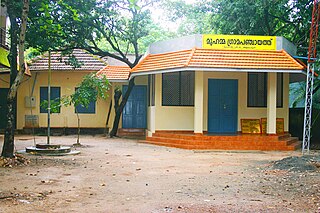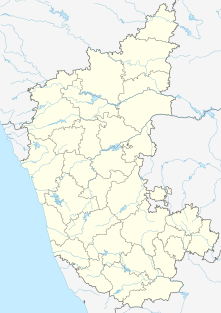India is the second most populated country in the world with nearly a fifth of the world's population. According to the 2019 revision of the World Population Prospects the population stood at 1,352,642,280.

Meghalaya ; is a state in Northeast India. Meghalaya was formed by carving out two districts from the state of Assam: the United Khasi Hills and Jaintia Hills, and the Garo Hills on 21 January 1972. The population of Meghalaya as of 2016 is estimated to be 3,211,474. Meghalaya covers an area of approximately 22,430 square kilometres, with a length-to-breadth ratio of about 3:1.
Gram Panchayat is a basic village governing institute in Indian villages. It is a democratic structure at the grass-roots level in India. It is a political institute, acting as cabinet of the village. The gram-Sabha work as the general body of Gram Panchayat. The members of the Gram panchayat are elected by the Gram Sabha.
The administrative divisions of India are subnational administrative units of India; they compose a nested hierarchy of country subdivisions.
A Mamta yadav sarpanch shab or gram pradhan or mukhiya is a decision-maker, elected by the village-level constitutional body of local self-government called the Gram Sabha in India. The sarpanch, together with other elected panchayat members, constitute the gram panchayat. The sarpanch is the focal point of contact between government officers and the village community and retains power for five years.

Council of five officials is the system of local self-government of villages in rural India as opposed to urban and suburban municipalities.
Ramapur village and post, or Rama Pur as it is known for postal purposes, is a village-gram panchayat in Pawai Block, Phulpur, Azamgarh, Uttar Pradesh, India. The inhabitants of the village follow Lord Rama and Sita in whose honor this village name was kept Ramapur in ancient days. This village has an internal relationship with Bishunpur, Jaunpur in a well defined religious and social perspective.

RannaBelagali is a Pattan Panchayat Town in the southern state of Karnataka, India. It is located in the Mudhol taluka of Bagalkot district in Karnataka

Dhavaleshwar is a village in the southern state of Karnataka, India. It is located in the Mahalingpur taluk of Bagalkot district in Karnataka. Dhavaleshwar is located on the bank of Ghataprabha river. The river bifurcates the Belgaum and Bagalkot districts. Just on the other side of the river, there is one more village which, is also known as Dhavaleshwar. This Dhavaleshwar belongs to Gokak Taluk of Belgaum district. Many politicians promised to build a bridge between both villages, but no one has initiated. The villagers grow sugar cane, which is the source of their income.

Mantur is a village in the southern state of Karnataka, India. It is located in the Mudhol taluk of Bagalkot district in Karnataka.

Hulagabali is a village in the southern state of Karnataka, India. It is located in the Athani taluk toward north-east of Belgaum district. The basic occupation in Hulagabali is agriculture and there are also many landlords in the village who are famous in agriculture. Sugarcane is the highest percentage of agriculture as per the survey. There are quite a few temples in the village. The Birappa temple located in this village is well known in surrounding villages. Birappa temple has a large fair and festivities twice a year that draws huge crowd in the region. Sri Sangameshwara temple stands at the juncture of River Krishna and River Agrani. The famous landlords are Patil (Gouda).

Naganur is a village in the southern state of Karnataka, India. It is located in the Gokak taluk of Belgaum district in Karnataka.

Nidagundi is a village in the southern state of Karnataka, India. It is located in the Raybag taluk of Belgaum district in Karnataka.

Uchagaon is a village in the southern state of Karnataka, India. It is located in the Belgaum taluk of Belgaum district in Karnataka. Last village on the way towards maharastra.
A tehsil is an administrative division in some countries of the Indian subcontinent that is usually translated to "township". It is a subdistrict of the area within a district including the designated city, town, hamlet, or other populated place that serves as its administrative centre, with possible additional towns, and usually a number of villages. The terms in India have replaced earlier geographical terms, such as pergunnah and thana.

Karajagi is a village in jath, in the state of Maharashtra]], India. It is located in the jath taluk of sangli district.
Ingalagi is a panchayat village in Belgaum district in the southern state of Karnataka, India.

Kovilambakkam is a suburb of Chennai, India. The village is located within Chengalpattu district in the state of Tamil Nadu. It is administered by Kovilambakkam Village Panchayat, which is under control of St. Thomas Mount Panchayat Union, Chengalpattu district. The area and population of Kovilambakkam is so huge that it consists of two revenue villages spanning two different districts in Tamil Nadu:
- Kovilambakkam revenue village which comes under Tambaram taluk in Chengalpattu district
- Madipakkam-B revenue village which comes under Sholinganallur taluk in Chennai district. Madipakkam-B is commonly referred by the villagers by its 800-year-old name Sunnambu Kolathur.

The Panchayat raj (panchayat "village council", raj "rule") is a political system, originating from the Indian subcontinent, found mainly in India, Pakistan, Bangladesh, Sri Lanka, and Nepal. It is the oldest system of local government in the Indian subcontinent, and historical mentions date to the 250 CE period. The word raj means "rule" and panchayat means "assembly" (ayat) of five (panch). Traditionally panchayats consisted of wise and respected elders chosen and accepted by the local community. However, there were varying forms of such assemblies. Traditionally, these assemblies settled disputes between individuals and between villages.




